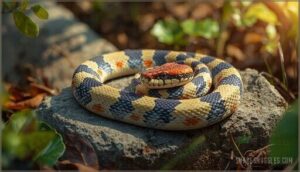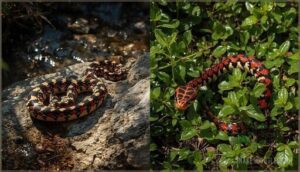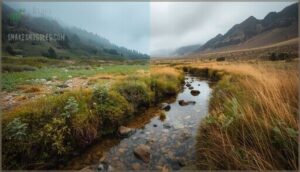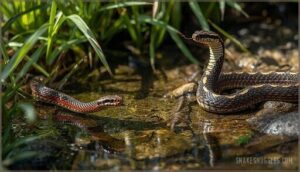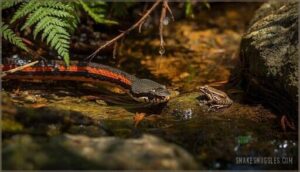This site is supported by our readers. We may earn a commission, at no cost to you, if you purchase through links.

Females can stretch beyond three feet, dwarfing their slender male counterparts by nearly 30%, while their distinctive orange-red crowns and irregular red blotches make them unmistakable among regional serpents.
These adaptable predators inhabit two separate coastal segments—one stretching from Humboldt to Monterey, another from Santa Barbara to San Diego—where they’ve mastered both aquatic and terrestrial hunting.
Despite their beauty and ecological importance, habitat fragmentation threatens their populations, making accurate identification and understanding their behavior essential for anyone encountering these snakes along California’s marine fringe.
Table Of Contents
- Key Takeaways
- California Red-Sided Garter Snake Identification
- Natural Range and Preferred Habitats
- Behavior, Activity, and Defense
- Diet and Ecological Role
- Reproduction and Conservation Status
- Frequently Asked Questions (FAQs)
- What are the ideal terrarium size and setup?
- How often should they be fed in captivity?
- Are they venomous or pose any risks as pets?
- What is their typical lifespan in captivity?
- Can different subspecies be housed together in captivity?
- Can they be kept as pets legally?
- What are their main predators in the wild?
- How do they survive winter in cold climates?
- Do they have any venom or defensive secretions?
- Conclusion
Key Takeaways
- Female California red-sided garter snakes can grow over three feet long—about 30% larger than males—and they’ve evolved a remarkable ability to safely consume toxic newts through specialized sodium channel mutations that resist lethal tetrodotoxin.
- You’ll find these snakes in two separated coastal segments (Humboldt to Monterey, and Santa Barbara to San Diego), where they thrive in wetlands, grasslands, and coastal forests by switching seamlessly between aquatic hunting and terrestrial movement throughout the day.
- Their diet consists primarily of amphibians (frogs and tadpoles make up 60% of what they eat), making them crucial regulators of wetland ecosystems and reliable indicators of habitat quality and water health along California’s coast.
- While currently listed as “Least Concern” globally, habitat fragmentation has destroyed over 70% of their coastal wetlands since the 1850s, and southern populations now carry “Species of Special Concern” status due to urbanization and climate-driven threats to their breeding sites.
California Red-Sided Garter Snake Identification
You’ll recognize this snake by its striking combination of colors and patterns. The California red-sided garter snake has distinct features that separate it from other snakes you might encounter in the state.
Let’s walk through the key identification markers that’ll help you spot one in the field.
Distinctive Coloration and Markings
You’ll recognize a California red-sided gartersnake by its eye-catching coloration and markings. The California gartersnake’s color and pattern include five key characteristics:
- Dorsal stripe: Blue to pale yellow running down the spine
- Red blotches: Irregular orange-red spots between stripes on the flanks
- Head color: Distinctive red or orange-red crown
- Ventral pattern: Pale blue or bluish-gray belly, often unmarked
- Geographic variation: Stripe intensity and red prominence vary by locality
These snake markings create a striking mosaic effect that sets this subspecies apart. As an ovoviviparous species, it gives birth to live young.
Size, Length, and Sexual Dimorphism
Beyond striking patterns, you’ll notice significant size differences in California redsided gartersnake (Thamnophis sirtalis infernalis) populations. Females generally reach 90–100 cm, while males measure 65–75 cm, creating 30% sexual dimorphism. Males exhibit marked slenderness compared to bulkier females.
Neonates start at 15 cm, then grow up to 3 mm daily during peak feeding. Growth rate depends on prey availability, and coastal mass averages slightly lower than inland populations. The species’ growth and development are influenced by its natural coastal ecosystems.
Scale Texture and Head Features
You’ll recognize Thamnophis sirtalis infernalis by its keeled dorsal scales—19 rows at mid-body—giving a rough, matte texture that aids traction on wet surfaces. The head is slightly wider than the neck, with vivid red-orange coloration concentrated on the snout and parietal scales.
Large eyes improve visual acuity for prey detection, while dorsolaterally positioned nostrils permit partial submersion. Labial scales—usually 10 lower and 7–8 upper—help jaw expansion during feeding.
This scale functionality and head shape support both aquatic adaptation and terrestrial movement, with color variation often tied to geographic location across California.
Comparison With Other Garter Snake Subspecies
Beyond the keeled scales and vivid head lies a subtler challenge: distinguishing T. s. infernalis from related California gartersnake subspecies. Unlike the San Francisco form (T. s. tetrataenia), which displays four bold stripes including a continuous red lateral band, the California red-sided garter snake exhibits a mottled red-and-black pattern on its flanks.
Key differences that’ll help you tell them apart:
- Coloration differences: T. s. infernalis shows blue lateral stripes on black-red backgrounds; tetrataenia has solid red bordered by black
- Size variations: infernalis averages 55 cm (max ~100 cm); tetrataenia reaches 120 cm
- Habitat overlap: intergrade zones along Santa Cruz Mountains produce hybrids with mixed traits
- Genetic lineage: Boundy and Rossman (1995) found close mitochondrial DNA ties, though subspecies remain distinct for conservation purposes
- Venom resistance: both Thamnophis sirtalis forms tolerate tetrodotoxin from rough-skinned newts, unlike most predators
The Valley garter snake (T. s. fitchi) replaces infernalis in southern Monterey County, showing broader vertebral stripes and subdued tones—making range the clearest identifier when coloration overlaps.
Natural Range and Preferred Habitats
You’ll find this distinctive subspecies spread across a surprisingly wide range of California environments. From coastal fog belts to inland valleys, these snakes have carved out territories that span thousands of feet in elevation.
Let’s look at where you’re most likely to encounter them and what draws them to specific landscapes.
Geographic Distribution in California
This California red-sided garter snake displays a distinctive coastal distribution split into two major population clusters. Northern populations span Humboldt County through Monterey County, while southern populations stretch from Santa Barbara County to northern San Diego County.
The gap between these segments—roughly 200 kilometers through central California—results from habitat fragmentation and range replacement by other subspecies. County occurrences concentrate within 10 miles of the Pacific coast, where legal recognition now mandates surveys before coastal development.
Elevational Range and Local Hotspots
You’ll find this subspecies thriving from sea level up to roughly 2,500 feet, with most populations hugging coastal elevation zones below 800 meters. Northern hotspots in Humboldt and Sonoma Counties stay under 350 meters, while central hotspots around Santa Cruz support populations between 20 and 200 meters. Southern habitats stretch from Santa Barbara to San Diego County, usually below 830 meters, though urbanization has fragmented these ranges.
Habitat influence from moisture and temperature at these elevations directly shapes the California gartersnake geographical range and gartersnake elevational range patterns you’ll observe.
Typical Environments (Wetlands, Grasslands, Forests)
You’ll encounter this subspecies across three primary California gartersnake habitats: freshwater marshes with cattails and bulrushes support the highest densities, grasslands within 50 meters of water provide upland refuges during drought, and coastal forests with riparian corridors offer shaded retreats.
Wetland ecology and grassland dynamics intertwine—habitat fragmentation from urbanization restricts ecosystem connectivity between these wetland habitats and terrestrial zones.
California red-sided garter snake characteristics include tolerance for variable forest habitat conditions, though populations concentrate where semi-permanent water meets vegetated cover.
Adaptations to Aquatic and Terrestrial Habitats
You’ll notice this subspecies thrives through a suite of physiological and behavioral specializations that bridge water and land. California redsided garter snake adaptations include:
- Aquatic locomotion via sleek undulation for pursuing amphibians in ponds
- Thermoregulation strategies like daily basking to maintain 28°-32°C body temperatures
- Toxin resistance enabling consumption of California newts other predators avoid
- Habitat selection favoring shoreline overlap zones for dual resource access
- Sensory adaptations including forked tongue chemoreception for prey detection across substrates
These snake behavior traits maximize foraging efficiency in aquatic and terrestrial snake species habitats.
Behavior, Activity, and Defense
You’ll find that California red-sided garter snakes aren’t just sitting still—they’re actively moving through their world with purpose. Their behavior changes with the time of day and season, and they’ve developed some clever ways to avoid becoming someone else’s meal.
Let’s look at how these snakes move, when they’re most active, and what they do when trouble shows up.
Daily and Seasonal Activity Patterns
You’ll notice these snakes are most active during daylight hours—what herpetologists call diurnal patterns—with peak movement in morning and late afternoon when temperatures hit that sweet spot.
California red-sided garter snake activity cycles shift dramatically with the seasons: they’re energetic hunters in spring and summer, then retreat to winter dens from late fall through early spring. Temperature adaptation drives their habitat usage; on hot days, they’ll dive into water to cool off and forage, while cooler periods find them basking in sunny patches.
California gartersnake behavior includes striking seasonal migration, with some populations traveling up to 18 kilometers between summer feeding grounds and hibernacula. Snake activity patterns reveal their notable ability to stay active at lower temperatures than most North American snake species.
Defensive Behaviors and Predator Avoidance
When threatened, you’re witnessing a complex arsenal of defensive strategies that shift based on the situation. The snake’s first line of defense is cryptic coloration—blending seamlessly into wetland vegetation—but once detected, it escalates quickly. If cornered, you’ll see striking visual threat displays: body flattening to appear larger, head triangulation mimicking venomous species, and tail-thrashing to confuse predators.
Key defensive behaviors include:
- Musk gland secretion – releasing pungent cloacal compounds (volatile fatty acids and sulfur) that repel predators and can kill small invertebrates like fire ants
- Flight versus fight – healthy adults generally flee rapidly (especially males), while recently fed or cornered individuals strike repeatedly with vigorous bite resistance
- Learned responses – defense varies by attack location; head-targeted threats trigger head-hiding and tail-waving, while mid-body attacks prompt open-mouthed displays or rapid escape
Temperature drives their choice: warmer snakes flee, cooler ones rely on aggressive displays.
California gartersnake behavior shows considerable plasticity—juveniles display erratic, less efficient snake defense mechanisms compared to adults, and defensive intensity varies across populations based on local predator pressure.
Swimming and Terrestrial Movement
You’ll see this snake’s versatility in action as it switches between land and water. On terrestrial ground, the California red-sided garter snake uses lateral undulation across substrates—hitting escape velocity up to 1.5 meters per second when fleeing. In aquatic hunting zones, it’s equally skilled, swimming for extended periods through marshes and streams to pursue fish and amphibians.
Habitat shift happens multiple times daily; radio telemetry shows snakes moving between basking sites and water as prey activity shifts. Thermal tolerance (18–30°C) facilitates this dual lifestyle, while scent trails help navigate complex garter snake habitats and distribution zones across wetlands.
| Movement Type | Speed/Duration | Primary Function |
|---|---|---|
| Terrestrial escape | Up to 1.5 m/s | Predator avoidance |
| Aquatic swimming | Extended periods | Hunting, dispersal |
| Daily shifts | Multiple per day | Foraging efficiency |
| Seasonal migration | 100+ meters | Reach water sources |
| Scent trail following | Up to 18 km | Hibernacula navigation |
Diet and Ecological Role
What you feed your California red-sided garter snake matters—and so does understanding what these snakes eat in the wild.
Their diet reflects an impressive adaptability that shapes their role in California’s ecosystems. Let’s look at what keeps these colorful serpents thriving and how their feeding habits ripple through the environments they inhabit.
Primary Prey and Feeding Habits
In natural environments, the California red-sided garter snake primarily feeds through amphibian consumption, with frogs and tadpoles making up over 60% of its diet and feeding intake. You’ll find it capturing prey using chemosensory tongue-flicking to detect chemical trails, then striking rapidly near shallow water edges.
Its diet shows seasonal variability—earthworms and slugs become more important during dry periods, while fish prey increases in spring. This feeding pattern influences ecosystem dynamics, as the snake helps regulate amphibian populations in wetland habitats.
Captive diets generally include frozen rodents and earthworms for best nutrition.
Ability to Consume Toxic Prey
Among the prey items you’ll encounter in this snake’s diet, toxic newts stand out as a striking feeding adaptation. Pacific newts contain tetrodotoxin—a neurotoxin deadly to most predators—but California red-sided garter snakes have evolved toxin resistance mechanisms through amino acid substitutions in their sodium channels. This geographic resistance variation creates a coevolutionary arms race:
California red-sided garter snakes evolved toxin resistance to hunt Pacific newts containing deadly tetrodotoxin, creating a remarkable predator-prey arms race
- Snakes retain up to 42 µg of TTX in their livers for weeks, becoming temporarily toxic themselves
- Resistance evolved roughly 40 million years ago through convergent genetic changes
- Despite their resistance, toxic newts make up only 3.2% of their natural diet
- Inland populations show stronger muscle resistance than coastal snakes, reflecting local prey toxicity
These evolutionary drivers and physiological consequences demonstrate how predator-prey dynamics shape both snake prey selection and ecological outcomes across California’s landscapes.
Role in Local Ecosystems
This subspecies regulates amphibian populations as a mid-level predator—frogs and salamanders comprise roughly 58% of their diet in northern populations—preventing trophic cascade effects that would otherwise destabilize wetland health.
You’ll find they serve as bioindicator species: their presence reflects habitat connectivity and water quality across California’s coastal ecosystems.
By linking aquatic prey regulation with terrestrial food webs, they maintain biodiversity equilibrium while simultaneously supporting raptors and mammalian predators as essential prey themselves.
Reproduction and Conservation Status
Understanding the California red-sided garter snake’s reproductive cycle and conservation status helps you appreciate why this subspecies thrives across much of its range. These snakes mate in spring and give birth to live young by late summer, a strategy that suits California’s varied climates.
While they’re not currently threatened, knowing their legal standing and habitat needs lets you support their continued success in the wild.
Mating, Gestation, and Birth
California Red-Sided garter snake Mating and Reproduction begins each spring when males emerge from brumation and form impressive mating aggregations—sometimes 100 males pursuing a single female. You’ll find these key reproductive facts fascinating:
- Mating Rituals: Males use pheromonal and thermal cues; copulation lasts 8–20 minutes
- Sperm Competition: Females store viable sperm up to 20 weeks from multiple mates
- Gestation Period: 2–4 months depending on temperature and locality
- Size of litter: Usually 10–20 live young, occasionally reaching 30–40 neonates
- Birth Timing: Late summer (July–September) before adults return to overwintering sites
Females mature at 2–3 years and reproduce biennially under favorable conditions. Reproductive cycles show males maturing earlier (1–2 years) at smaller body sizes.
Population Trends and Threats
Despite its adaptability, the California Red-Sided garter snake faces mounting conservation issues. Habitat loss and habitat fragmentation from urbanization have eroded over 70% of coastal wetlands since the 1850s, driving population decline.
Climate impacts—droughts, wildfires, altered precipitation—degrade breeding sites and prey availability. Invasive predators like bullfrogs increase mortality and competition.
Human disturbance from recreation, roads, and illegal collection compounds these threats, leaving populations fragmented and vulnerable across much of their California habitat.
Legal Protection and Conservation Efforts
Under Title 14 of the California Code of Regulations, you’ll find the California Red-Sided garter snake protected from unpermitted collection and trade. Wildlife permits allow limited possession—up to two individuals with a valid sport fishing license—but commercial breeding remains off-limits.
Habitat restoration projects target coastal wetlands in San Mateo and Santa Cruz counties, while conservation laws enforce strict anti-poaching measures. Multi-agency partnerships restore grassland and pond ecosystems, addressing California Gartersnake Conservation Issues and supporting Endangered Species recovery through Environmental Policy and coordinated Wildlife Permits oversight.
Current IUCN and State Status
You’ll find the IUCN Conservation Status remarkably unclear for this subspecies. The California Red-Sided garter snake lacks an independent IUCN Listings entry—it inherits “Least Concern” Threat Status from its parent species, masking regional California Gartersnake Conservation Issues.
- State Conservation Rankings classify it as “Unranked” statewide, though southern coastal populations receive Species of Special Concern designation
- Habitat Protection focuses on wetland preservation rather than Species Legislation targeting this snake specifically
- Conservation Status reflects data gaps: globally secure, yet locally vulnerable to fragmentation and urban expansion
Frequently Asked Questions (FAQs)
What are the ideal terrarium size and setup?
You’ll want at least a 36″L x 18″W x 18″H enclosure for adults, though larger is better for active snakes.
Use naturalistic substrate like topsoil mixed with sand, maintain 85-90°F basking spots with proper temperature gradients, and add climbing branches plus hiding spots for enrichment.
How often should they be fed in captivity?
Getting the diet right isn’t rocket science—you’ll feed juveniles every two to three days to fuel rapid growth, while adults thrive on a five-to-seven-day schedule.
Adjust feeding frequency based on prey size, diet composition, and seasonal factors; California Red-Sided garter snakes naturally consume varied prey items meeting their nutritional needs.
Are they venomous or pose any risks as pets?
California Red-Sided garter snakes produce mild neurotoxic venom that’s harmless to humans, causing only minor swelling or irritation.
You’ll face greater risk from zoonotic diseases like Salmonella through improper handling, making good hygiene essential when keeping them as pets.
What is their typical lifespan in captivity?
In captivity, you’ll find these snakes usually live 6–10 years, though ideal husbandry practices—including a varied diet, proper environmental enrichment, and consistent health management—can extend life expectancy to 15 years or more.
Can different subspecies be housed together in captivity?
Cohabitation of subspecies in captive environments presents challenges, including Hybridization Risks and Disease Transmission.
You’ll need strict Captive Management protocols—quarantine, Environmental Enrichment, and health monitoring—to protect Genetic Integrity while minimizing stress and pathogen spread among snake subspecies.
Can they be kept as pets legally?
While wild-caught individuals are strictly illegal without permits, you can legally own captive-bred California Red-Sided garter snakes if you obtain them from licensed breeders with proper documentation—protecting wild populations while enabling responsible reptile care.
What are their main predators in the wild?
Hawks, owls, herons, raccoons, foxes, skunks, and large fish like bass regularly hunt these snakes. Terrestrial risks from mammals and wild threats from aquatic dangers like snapping turtles shape their behavior constantly.
How do they survive winter in cold climates?
How do snakes handle freezing nights without ice crystals tearing through their cells? California red-sided garter snakes enter brumation when temperatures drop below 16°C, retreating to communal hibernacula like rodent burrows.
They supercool to -5°C, suppress metabolism by 95%, and produce glucose-based cryoprotectants—surviving winter through thermoregulation and metabolic suppression until spring warmth triggers emergence.
Do they have any venom or defensive secretions?
Yes, you’ll find they produce mild neurotoxic venom effective against small prey like frogs and fish, but it’s harmless to humans—maybe causing slight swelling.
They also release foul-smelling musk from cloacal glands when threatened, deterring predators effectively.
Conclusion
Remarkably, female California red-sided garter snakes can retain viable sperm for months, allowing them to time births with ideal prey availability. Their ability to consume toxic newts without harm underscores their specialized niche.
If you’ve encountered this subspecies along California’s coast, you’ve witnessed a resilient predator whose patchy distribution reflects decades of wetland loss. As development fragments their remaining habitat corridors, protecting these serpents means preserving the coastal ecosystems they’ve quietly inhabited for millennia. Their survival depends on our willingness to coexist.

